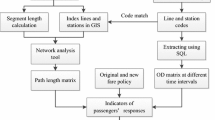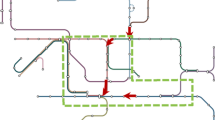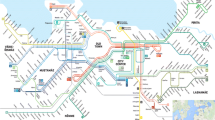Abstract
Public transport fare is a central feature of transit operations and is a key indicator to reflect transport demand. Yet, relatively little is known about how fare influences on ridership dynamics, including for which types of fare incentives, who accepts it, and how passengers’ travel patterns are changed. This information is particularly important considering concerns about a decline of public transport ridership due to the aging population and pandemic. In this paper, we employ a flat-rate public transport fare as an urgent measure to revive the demand for public transport in rural areas of Japan. A discrete-continuous model is applied to describe the relationship between the intention to use flat-rate public transport and trip frequency. A stated preference survey was conducted with citizens living near the station and bus stops in Kochi Prefecture. This study contributes to the literature by providing firsthand insights about how demand for flat-rate public transport fares is formed and how different policy implications can be made accordingly. The results indicate that a flat-rate fare has proven effective in increasing the frequency of use of public transportation, which will lead to the revitalization of the public transport system. The outcome of this study is anticipated to inform and equip city authorities and operators with advanced knowledge about the benefits of flat-rate fares which can help to change fare policies in the near future.



Similar content being viewed by others
Explore related subjects
Discover the latest articles, news and stories from top researchers in related subjects.References
Amore MD, Murtinu S (2021) Tobit models in strategy research: Critical issues and applications. Global Strategy J 11(3):331–355. https://doi.org/10.1002/gsj.1363
Ballou DP, Mohan L (1981) A decision model for evaluating transit pricing policies. Transp Res Part A Gener 15(2):125–138. https://doi.org/10.1016/0191-2607(81)90078-9
Brechan I (2017) Effect of price reduction and increased service frequency on public transport travel. J Public Transp 20(1):139–156. https://doi.org/10.5038/2375-0901.20.1.8
Brown J, Hess DB, Shoup D (2003) Fare-free public transit at universities: An evaluation. J Plan Educ Res 23(1):69–82. https://doi.org/10.1177/0739456X03255430
Cats C, Susilo Y-O, Reimal T (2017) The prospects of fare-free public transport: evidence from Tallinn. Transportation 44:1083–1104. https://doi.org/10.1007/s11116-016-9695-5
Cervero R (1982) The transit pricing evaluation model: a tool for exploring fare policy options. Transp Res Part A Gener 16(4):313–323. https://doi.org/10.1016/0191-2607(82)90058-9
Daskin MS, Schofer JL, Haghani AE (1988) A quadratic programming model for designing and evaluating distance-based and zone fares for urban transit. Transp Res Part B Methodolog 22(1):25–44. https://doi.org/10.1016/0191-2615(88)90032-X
Farber S, Bartholomew K, Li X, Páez A, Habib KMN (2014) Assessing social equity in distance based transit fares using a model of travel behavior. Transp Res Part A Policy Pract 67:291–303. https://doi.org/10.1016/j.tra.2014.07.013
Fujigaki Y, Takami K, Ohmori N, Harata N (2014) Feasibility study of flat-rate shared-ride taxi services with high convenience in major metropolitan suburban area—a case study in a residential district in Tajimi City. J City Plan Inst Japan 49(3):369–374. https://doi.org/10.11361/journalcpij.49.369
Fujigaki Y, Takami K, Parady G-T, Harata N (2017) “Metro-MaaS”, an integrated mobility service concept for megacities—concept proposal and demand evaluation aiming at future integration of autonomous demand-responsive-transit and existing public transportation. J City Plan Inst Jpn 52(3):833–840. https://doi.org/10.11361/journalcpij.52.833. (in Japanese)
Fujii S, Kitamura R (2003) What does a one-month free bus ticket do to habitual drivers? An experimental analysis of habit and attitude change. Transportation 30:81–95. https://doi.org/10.1023/A:1021234607980
Fukuda D, Chikaraishi M (2013) A review on discrete-continuous models. J Jpn Soc Civ Eng Ser. D3 (Infrastructure Planning and Management) 69(5):I_497-I_510. https://doi.org/10.2208/jscejipm.69.I_497. (in Japanese)
Ghimire R, Lancelin C (2019) The relationship between financial incentives provided by employers and commuters’ decision to use transit: results from the Atlanta regional household travel survey. Transp Policy 74:103–113. https://doi.org/10.1016/j.tranpol.2018.11.005
Guo Q, Sun Y, Schonfeld P, Li Z (2021) Time-dependent transit fare optimization with elastic and spatially distributed demand. Transp Res Part A Policy Pract 148:353–378. https://doi.org/10.1016/j.tra.2021.04.002
Hamre A, Buehler R (2014) Commuter mode choice and free car parking, public transportation benefits, showers/lockers, and bike parking at work: evidence from the Washington, DC region. J Public Transport 17(2):67–91. https://doi.org/10.5038/2375-0901.17.2.4
Hensher DA (1998) Establishing a fare elasticity regime for urban passenger transport. JTEP 32(2):221–246
Hensher DA, King J (1998) Establishing fare elasticity regimes for urban passenger transport: time-based fares for concession and non-concession markets segmented by trip length. J Transport Stat 1(1):43–61. https://doi.org/10.21949/1501474
Jittrapirom P, Caiati V, Feneri A-M, Ebrahimigharehbaghi S, Alonso M-J, Narayan J (2017) Mobility as a service: a critical review of definitions, assessments of schemes, and key challenges. Urban Plan 2(2):13–25. https://doi.org/10.17645/up.v2i2.931
Lambrecht A, Skiera B (2006) Paying too much and being happy about it: existence, causes, and consequences of tariff-choice biases. J Mark Res 43(2):212–223. https://doi.org/10.1509/jmkr.43.2.212
MaaS Global (2022) Whim travel by MaaS Global, https://maas.global/, Accessed 1 Nov 2022
Ministry of Land, Infrastructure, Transport and Tourism (MLIT) (2019) White Paper on Land, Infrastructure, Transport and Tourism in Japan. https://www.mlit.go.jp/common/001325161.pdf. Accessed 7 Aug 2023
Murai F, Shiomi Y (2019) A feasibility study on subscription bus services. J Jpn Soc Civ Eng Ser. D3 Infrastruct Plan Manag 75(5):1177–1187. https://doi.org/10.2208/jscejipm.75.I_1177
Myung-Jin J, Ji-Eun J, Hyun-Ju A (2018) The welfare effects of the free subway fare scheme for seniors: a discrete choice approach with the case of Seoul. Case Stud Transport Policy 6(4):642–650. https://doi.org/10.1016/j.cstp.2018.08.003
Nishiuchi H, Kobayashi Y, Todoroki T, Kawasaki T (2018) Impact analysis of reductions in tram services in rural areas in Japan using smart card data. Public Transport 10(2):291–309. https://doi.org/10.1007/s12469-018-0185-3
Nuworsoo C, Golub A, Deakin E (2009) Analyzing equity impacts of transit fare changes: case study of Alameda-Contra Costa Transit California. Eval Program Plan 32(4):360–368. https://doi.org/10.1016/j.evalprogplan.2009.06.009
Page E (1981) Factors that influence choice among transit payment methods: a study of pass use in Sacramento. Transp Res Rec 799:20–26
Paulley N, Balcombe R, Mackett R, Titheridge H, Preston J, Wardman M, White P (2006) The demand for public transport: The effects of fares, quality of service, income and car ownership. Transp Policy 13(4):295–306. https://doi.org/10.1016/j.tranpol.2005.12.004
Policy Research Institute for Land, Infrastructure, Transport and Tourism (2021) Report of Service Improvement in Regional Public Transport. https://www.mlit.go.jp/pri/houkoku/gaiyou/pdf/kkk165.pdf. Accessed 7 Aug 2023 (in Japanese)
Shin EJ (2020) Commuter benefits programs: Impacts on mode choice, VMT, and spillover effects. Transp Policy 94:11–22. https://doi.org/10.1016/j.tranpol.2020.05.001
Shin EJ (2021) Exploring the causal impact of transit fare exemptions on older adults’ travel behavior: Evidence from the Seoul metropolitan area. Transp Res Part A 149:319–338. https://doi.org/10.1016/j.tra.2021.05.007
Simic V, Gokasar I, Deveci M, Karakurt A (2022) An integrated CRITIC and MABAC based type-2 neutrosophic model for public transportation pricing system selection. Socio-Econ Plan Sci 80:101157. https://doi.org/10.1016/j.seps.2021.101157
Srivatsa Srinivas S (2023) To increase or to decrease the price? Managing public transport queues during COVID-19 in the presence of strategic commuters. Public Transport 15:275–285. https://doi.org/10.1007/s12469-022-00314-3
Thogersen J (2009) Promoting public transport as a subscription service: effects of a free month travel card. Transp Policy 16(6):335–343. https://doi.org/10.1016/j.tranpol.2009.10.008
Vickrey WS (1955) A proposal for revising New York’s subway fare structure. J Oper Res Soc Am 3(1):38–68. https://doi.org/10.1287/opre.3.1.38
Voß S, Mejia G, Voß A (2020) Mystery shopping in public transport: the case of bus station design. In: HCI International 2020 - Late breaking papers: User experience design and case studies. Lecture notes in computer science, vol 12423, pp 527–542https://doi.org/10.1007/978-3-030-60114-0_36
Wiener Linien (2022) www.wienerlinien.at, Accessed 1 Nov 2022
Yoshida I (2020) A feasibility study on flat-rate taxi services in small provincial cities—a case study in Minamisoma City of Fukushima Prefecture-. JSTE J Traffic Eng 6(2):A_183-A_189. https://doi.org/10.14954/jste.6.2_A_183
Acknowledgements
This work was partially supported in part by a grant from Japan Society for the Promotion of Science (JSPS KAKENHI Grant Number 22H01618).
Author information
Authors and Affiliations
Corresponding author
Ethics declarations
Conflict of interest
The authors state no conflict of interest.
Ethical approval
The study was conducted according to the guidelines of the Declaration of Helsinki, and conducted in accordance with the guidelines of the Kochi University of Technology Ethics Regulations. The online survey in this paper was voluntary, anonymous, and self-administered. Participants’ consent is implied by the completion of the survey. This material is the authors' own original work, which has not been previously published elsewhere. The paper is not currently being considered for publication elsewhere. The paper reflects the authors’ own research and analysis in a truthful and complete manner. All authors have been personally and actively involved in substantial work leading to the paper, and will take public responsibility for its content.
Additional information
Publisher's Note
Springer Nature remains neutral with regard to jurisdictional claims in published maps and institutional affiliations.
Rights and permissions
Springer Nature or its licensor (e.g. a society or other partner) holds exclusive rights to this article under a publishing agreement with the author(s) or other rightsholder(s); author self-archiving of the accepted manuscript version of this article is solely governed by the terms of such publishing agreement and applicable law.
About this article
Cite this article
Nishiuchi, H., Nishimura, K., Ngoc, A.M. et al. Identifying the relationship between intention to use flat-rate public transport and trip frequency by a discrete-continuous model. Public Transp 16, 485–504 (2024). https://doi.org/10.1007/s12469-023-00341-8
Accepted:
Published:
Issue Date:
DOI: https://doi.org/10.1007/s12469-023-00341-8




